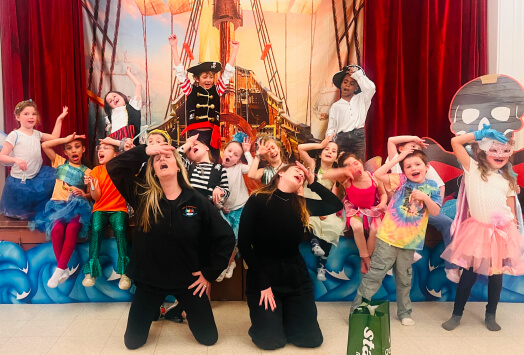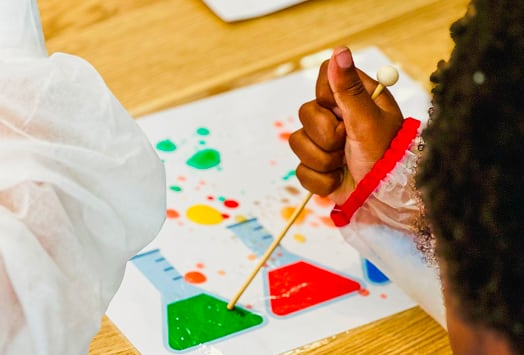As children grow, they constantly learn about the world around them. They are naturally curious about why the sky is blue or how bubbles work, which makes them great students for science classes! If you are a STEM or science professional, then teaching science to children is a great way for you to turn your passion into a business and help inspire the next generation of scientists.
To help you prepare, we’ve outlined some best practices for teaching kids science as well as science lessons, experiments, projects, and activities that children of all ages will enjoy. And if you want to learn how to write a curriculum, check out our guide!
- How to teach kids science
- Lesson plan for science
- Science experiments for kids
- Science projects for kids
How to teach kids science
Before you sit down to write a lesson plan or organize your curriculum, you need to know best practices for teaching science to children. At Sawyer, we work with educators every day to create the best versions of their business. To help you get started, here are some of our top tips on how to teach kids science.
Let the children lead the discussion
If you are teaching a semester of science classes, start by asking the children what they want to learn. Do they have science questions that you can discover together? Of course, you will need to plan your own lessons and curricula, but try to add 10-15 minutes of each class to discuss these questions and explore them with the children.
Make it as interactive as possible
Since you are likely teaching extracurricular science classes, fun should be a priority! Science lends itself very well to interactive learning, so make sure to include lots of experiments, activities, games, and other hands-on projects to keep the children engaged and interested. Playing games enhances classroom learning and helps students with focus and attention.
Connect the lesson to their lives
One of the best parts about teaching science is showing students that science is all around them. You can ask your students to look for connections between what they discover in your classes, what they’re learning in school, and what they see out in the world.
For example, if you teach a lesson about gases, liquids, and solids, ask your students to take note of these states in objects or food items in their home. Then, you can start the next lesson with a discussion on what they found.

Lesson plan for science
Lesson plans are necessary for efficient and effective teaching. They help you organize your ideas before class, keep you on track while teaching, and ensure that your students are learning what they need to accomplish goals. This is especially important for a subject like science, which can be tougher for children to understand. To help you create a great lesson plan for science classes, we’ve outlined how to write a lesson plan and included the components below.
Lesson objective(s)
What is the goal of your class? Are you teaching students about the different types of rocks, doing a chemistry experiment, building a 3D model, or something else? Use action-oriented language here so you can easily evaluate your success at the end of the class.
Materials needed
What materials will you need for the various activities in this lesson? If you are teaching about rocks, you need to bring in the different types of rocks to show the children. Likewise, if you are doing an experiment or building models, create a list of what you need. Not sure where to buy supplies? Check out our guide.
Lesson activities & timing
In this section of your lesson plan, you should break down the class time into small activities. Make these activities interactive and engaging so students stay focused.
In your lesson plan, you can start with a refresh of what students have already learned. Try an interactive Jeopardy! style game or a different type of game so children have fun while remembering. Then, you can move into a brief overview of what the students will learn in that day’s class. The middle section of the class time should be your main activity, which should be hands-on. At the end of the class, include a flex activity that you can do or skip based on time.
Include time estimates next to each activity so you can keep yourself on track during the class. Add a little buffer time as well so you don’t run over.
Assessment
This is mainly for your own use, though parents might ask how their child is doing in your classes. Since you are likely not teaching in a school, you probably want to avoid tests or quizzes. Instead, you can utilize group projects or experiments, science fairs (for fun), and games to assess how your students are doing.
Evaluation
Use this space to take some notes during and after the class to reflect on what went well and what could have been improved. This will help you as you write your next lesson plans and develop your classes moving forward.
Get your editable science lesson plan template

Science experiments for kids
Now that you know how to write science lessons, you need to think of some great science experiments for kids to do in your activities. For inspiration, check out this list of fun science experiments for kids. Just remember that children vary in their abilities, so make sure you have enough adults in the room to provide support and ensure a safe and enjoyable environment.
- Explore solutions and density. Fill 4 glasses of water with tap water. Then, have the children create solutions in 3 of the 4 glasses (keep the fourth one as is to be your control). Add 2 tablespoons of baking soda in the first glass, 2 tablespoons of sugar in the second glass, and 2 tablespoons of salt in the third glass. Finally, have the children drop small objects in each glass to see if they float and learn about how solutions affect density.
- Limestone or not? For this experiment, have the children collect rocks outside. Then, pour white vinegar over each individual rock until half of the rock is covered. If it bubbles, then the rock is limestone! Use this experiment to talk about the different types of rocks, acidity in the vinegar, and how bubbles are created.
- Water cycle in a jar. Pour around 2 inches of hot water into a heat-safe jar and then cover with a plate face-up. Wait a few minutes, then add a couple ice cubes to the plate. Watch closely as the water cycle forms in the jar! Use this experiment to show the water cycle to your students and explain what is happening.
- Dyed flowers. Cut the end of the stems from 3 white carnations. Then, fill 3 different glasses with water and place 3 drops of food coloring in each one. Place the carnations in the glasses and observe how the colored water is absorbed into their petals. Note: this takes at minimum an hour to see any change, but after a day or more, it is even more visible.
- Make liquids dance. Mix water, flour, and food coloring together and then pour onto a thin plate. Put the plate on top of a speaker and play music. Watch as the liquid “dances” to the beat. Try different types of songs so students can see the changes in the vibrations.

Science projects for kids
Science activities for kids are great when you want to really make your lessons stick. These projects are hands-on and interactive so that children will have fun and, most importantly, remember what they learn. Check out some of our favorite activities and science projects for kids.
- Egg drop. Challenge your students to build containers that will protect an egg from a fall. They can use any materials you provide, like straws, sponges, tape, paper cups, plates, and bowls, rubber bands, and more. This is a great science project for kids who are interested in engineering.
- Core sampling. Use different colored playdough to create the different layers of the Earth. Then, children can push a straw through the playdough and get a perfect sample of the layers stuck in the hole of the straw. Use this experiment to teach children about the layers of the Earth and geologists. If you want to make homemade playdough for your class, check out our guide.
- Ice fishing. Place ice cubes in a bowl of water and then place a string on top of the cubes. Add salt where the string and cubes touch, then wait for the water to melt and refreeze. Then, let the children pull the string and watch as the ice comes, too!
- Fireworks in a glass. Start with 2 tall glasses. Fill one mostly to the top with water. In the other, add 2 tablespoons of oil and 2 drops of food coloring. Mix up the contents of the second glass until the food coloring begins to break down into smaller droplets. Then, pour the oil and food coloring mixture into the water cup and watch the “fireworks”!
- Clean pennies. Put a dirty penny in a cup and cover it with lemon juice. Take it out after about 5 minutes and wipe it with a paper towel to see your shiny, new penny. Explain how the acid from the lemon juice oxidizes the copper and cleans it.

Creating science lessons and activities for children is a great way to teach little ones about the world around them and inspire their curiosity. If you are looking for guidance on managing and running your children’s education and activity business, the team at Sawyer is here to help. We work with educators every day to save time on admin, spend more time in the classroom, and grow their business. See how we do it with a free trial or demo today.





















.png)












.avif)
.avif)
.avif)
.avif)




